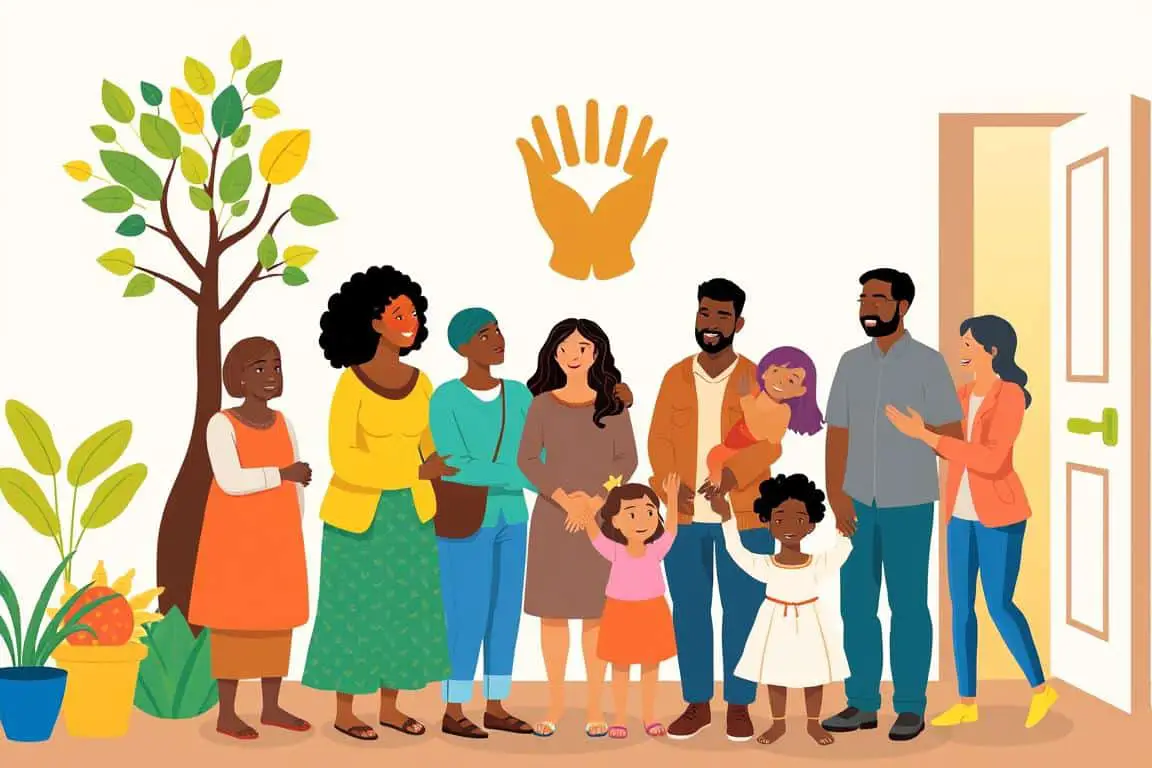Everything You Need to Know About TANF: Financial Relief for Families in Need

Welcome to the world many families live in today. Here, daily life is about getting by, not getting ahead. Think of the single mom, working two jobs, yet still struggling. Or consider a dad who lost his job when his company closed. These stories are real and happening now. They show why TANF is so important for low-income families aiming for a better future12.
TANF is more than just emergency help. It offers financial assistance, childcare, transportation, and more. It’s a way for the state and community to help individuals maintain their dignity. By giving parents the resources they need, TANF helps them move towards jobs and independence12. Each state customizes its TANF programs, so knowing about them is essential for those in need3.
TANF is designed to encourage work and reduce dependence on aid. It aims to prepare people for jobs and empower them. Knowing all about TANF can open doors to many opportunities and supports12.
Key Takeaways
- TANF, a beacon of hope, provides more than just temporary relief but a pathway to long-term stability.
- Understanding TANF eligibility requirements is essential to access its wide-ranging benefits effectively.
- State-specific administration of TANF allows for tailored approaches to family support programs.
- Appreciating the TANF program’s history and evolution can enhance one’s pursuit of economic independence.
- Being aware of the types of assistance TANF offers is key to fully utilizing the program’s potential.
Understanding the Basics of TANF
The Temporary Assistance for Needy Families (TANF) program is key for low-income families in the United States. It offers essential financial support. This helps lessen the financial challenges many families face.
States have a lot of freedom to shape their TANF programs. They design these programs to meet local needs while following federal rules. TANF offers varied support, like cash help, childcare, and job training. These services aim to boost self-reliance and family stability.
Financial Insights: States are required to use at least 75% of their previous welfare funds for current services. This shows a commitment to vital aid programs4. Yet, cash help is less than a third of all TANF and state spending. This points to a strong focus on non-cash aid5.
The Work Participation Rate (WPR) is key for measuring TANF’s success5. Single parents on TANF need to do work activities for 30 hours weekly. For two-parent families, it’s 35 hours4.
TANF follows strict policies set in 1996. The Personal Responsibility and Work Opportunity Reconciliation Act ended guaranteed cash help. It stressed short-term support4. This law also let states have more control in creating TANF programs4.
However, TANF’s reach has dropped; only 21 out of 100 needy families got help in 2020. This is much less than in 19966. If coverage had stayed the same, 2.4 million more families would benefit now6.
The 2009 Great Recession showed TANF’s importance during tough times. With unemployment at 10%, poverty surged5. Now with a $16.5 billion budget for 2021, TANF is crucial for many families4.
The TANF program is a cornerstone of the U.S. social safety net. By working together, state and federal efforts not only fight poverty but also support family resource centers. This helps ensure long-term economic well-being and growth.
Government assistance for families: How TANF Supports Economic Stability
The Temporary Assistance for Needy Families (TANF) program is crucial for families in need. It gives government grants that help keep kids out of foster care and reduce child abuse. This support helps create a secure environment for children.
Recent research shows that more TANF benefits greatly improve the well-being of children and families.
Eligibility Requirements for TANF
To get TANF, you must meet several requirements. You need a minor child, fall under set income limits, and live in the state. Most adults must work unless there’s a reason they can’t. This condition links TANF support to efforts aimed at reducing reliance on government help through jobs.
Types of Assistance Offered by TANF
TANF does more than just hand out money. It offers food, housing, and child care support to strengthen family welfare. These aspects are crucial for giving families a strong economic base.
| Type of Assistance | Description | Impact on Families |
|---|---|---|
| Financial Aid | Monthly cash benefits for basic needs | Direct impact on living conditions and reduces poverty levels |
| Job Training | Employment and training services | Increases employment prospects and potential earnings |
| Child Care | Subsidies to help with childcare expenses | Enables parents to work or receive training |
Navigating TANF Application and Benefits Management
It’s important to know how to apply for TANF correctly. Understanding your rights and duties within the program ensures you keep getting help.
TANF Work Program: Bridging the Gap Between Assistance and Employment
The TANF Work Program helps families move from aid to work. It includes job training, work experience, and job search help. This is key for achieving independence7.
In Mississippi, TANF recipients get part of their child support directly. This boosts their financial stability as they seek jobs, showing the program’s aim for families’ lasting economic success7.
By mixing financial help with job support, TANF stands as a key pillar of government aid for families. It addresses urgent needs and fosters long-term success. Applying for TANF could greatly improve your family’s life and financial steadiness.
Conclusion
The Temporary Assistance for Needy Families (TANF) program is a crucial support system. It offers welfare services and government grants to families facing hard times. In 2012, a staggering 21.3% of all U.S people were part of a government aid program8. This shows the huge role of TANF in helping families lift themselves out of poverty8.
In 2019, more Americans got help, with 72.5 million on Medicaid and 38 million using SNAP8. These programs make sure families have health care and enough to eat. Most SNAP benefits, 86%, went to homes with kids, the elderly, or disabled family members8. This shows a strong focus on aiding those who need it most. A big part of those getting help were Black or Hispanic families, showing TANF’s wide impact8.
Knowing if you qualify for family aid can greatly aid your financial recovery. TANF and SNAP have time limits, usually five years or less8. It’s key to apply early and know what help you can get. Using the aid TANF provides can make your road to doing well on your own smoother and more lasting. Studies show how important it is to know how welfare, work rewards, and economic changes mix together9.
If you’re a single parent working hard for your kids or just in a rough spot, understanding the role of TANF is key. Knowing about these aids can change how we think about poverty and solving it. With these supports, the aim is to build strong, self-reliant community members. They, in turn, can make our economy stronger and more welcoming for everyone.
FAQ
What is the TANF program?
Who is eligible for TANF benefits?
What types of assistance does TANF provide?
How do I apply for TANF benefits?
What responsibilities do I have while receiving TANF benefits?
How does TANF support work readiness and employment?
How can I get help if I have issues with my TANF benefits?
Can TANF provide assistance for immediate needs like food or housing?
How long can a family receive TANF assistance?
Does receiving TANF assistance affect other government benefits?
Source Links
- Financial Help – https://dwss.nv.gov/TANF/Financial_Help/
- TANF: Temporary Assistance for Needy Families – https://benefits.com/food-stamps/tanf/
- TANF FAQs – https://governor.ohio.gov/priorities/faith-based-initiatives/grant-initiatives/tanf-faqs
- Temporary Assistance for Needy Families – https://en.wikipedia.org/wiki/Temporary_Assistance_for_Needy_Families
- TANF 101: Policy Briefs on Temporary Assistance for Needy Families | CLASP – https://www.clasp.org/tanf-101-policy-briefs-temporary-assistance-needy-families/
- The Temporary Assistance for Needy Families (TANF) Program & Higher Education – https://hope.temple.edu/state-state-choices-national-landscape-analysis-postsecondary-eligibility-restrictions-opportunities-snap-ccdf-tanf/temporary-assistance-needy-families-tanf-program-higher-education
- Using TANF Funds to Provide Cash to Families: Considerations and Resources – https://www.urban.org/sites/default/files/2024-08/Using TANF Funds to Provide Cash to Families.pdf
- Financial Behaviors, Government Assistance, and Financial Satisfaction – Social Indicators Research – https://link.springer.com/article/10.1007/s11205-022-03051-z
- 4 How the Labor Market, Family Structure, and Government Programs Affect Child Poverty | A Roadmap to Reducing Child Poverty – https://nap.nationalacademies.org/read/25246/chapter/6







